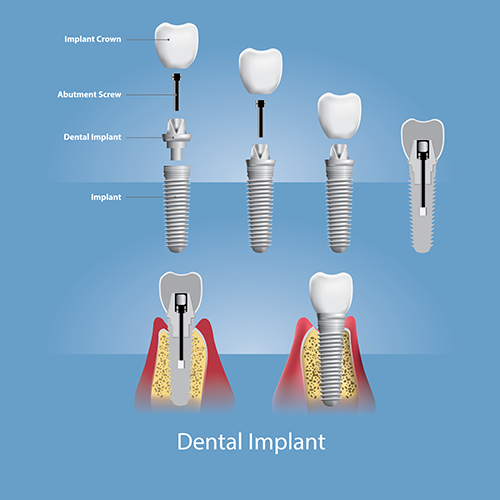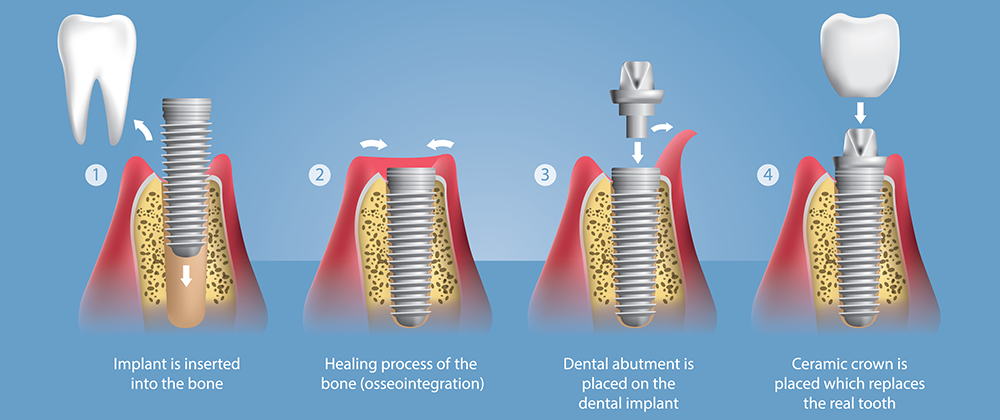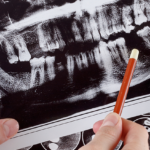Understanding the Components of a Dental Implant
Replicating the Look and Feel of a Natural Tooth:
A dental implant is designed based on the structure of a natural tooth, which is generally said to comprise two primary components: the crown visible above the gums and the root firmly situated beneath the gum.

A Close-up
Look at the Components of a Dental Implant – the Titanium Post, Abutment, and Crown.
Implant Crown: The implant crown is intricately designed to emulate the appearance and sensation of a natural, healthy tooth, creating a seamless integration with your oral system.
Implant: The implant is a substitute for the natural tooth root and can last a lifetime if properly maintained. It instigates the bone cells to connect to the implant’s titanium thread, forming an utterly steady base for the new crown. This process is referred to as osseointegration. It typically takes between 8 and 12 weeks for the bone to adhere to the entire surface of the implant firmly.
Missing a Single Tooth
The opportunity to extract a decayed tooth, install the implant, and construct a tooth directly onto the implant within one appointment is feasible, as is the process known as “Instant Implants” and “Instant Teeth.”
Missing Multiple Teeth
A fixed implant bridge procedure consists of placing two or more dental implants. These implants offer firmness and stimulate the neighboring bone, helping to prevent excessive bone loss. Crowns are then made and linked to the implants, with a central crown positioned over the gums.
Implant-supported bridges provide a remarkably stable and long-lasting solution for multiple missing teeth.
Missing all Your Teeth
To support a bridge for all missing teeth, you only need 4 to 6 implants, significantly minimizing the bone loss associated with traditional dentures.
Dental implants offer a stable, prolonged solution, reducing the pain, discomfort, instability, and bone loss that people with dentures typically encounter.
Another popular option is to opt for a denture anchored in place with implants.
Alternative Options to Having a Dental Implant
Partial dentures are a cost-effective and quick fix for missing teeth, but many individuals find them bulky and uncomfortable. They often become loose, leading to challenges and social awkwardness during meals, and they need to be taken out at night. Additionally, they can contribute to bone loss and impact the health of adjacent teeth.
Stick-on bridges can be suitable for certain situations but are prone to dislodging if excessive biting pressure is exerted. Due to the absence of a natural tooth root, the bone above the crown gradually diminishes, leading to potential complications.
Fixed bridges require a high-speed drill to remove a considerable portion of adjacent teeth to prepare them for the bridge. Unfortunately, this process damages the teeth and reduces their lifespan. The additional strain placed on the supporting teeth often results in bridges lasting an average of 10 to 12 years before needing replacement. Ultimately, this can lead to the loss of the supporting teeth.
The consequences of doing nothing Neglecting to replace lost teeth has more than just cosmetic repercussions. It places increased strain on the remaining teeth during chewing, potentially leading to the loss of additional teeth over time. The augmented forces on the remaining teeth gradually escalate, eventually causing them to become loose or fractured.
Choosing not to take any action after losing teeth can have various consequences. Aside from the obvious aesthetic concerns, the remaining teeth bear increased chewing forces due to the absence of the lost teeth. This can eventually lead to further tooth loss as the pressure on the remaining teeth intensifies, causing them to become loose or even fracture.
If you have questions or need additional information, please Contact Us or Request a Quote to send us your dental inquiry, and we’ll get back to you.











